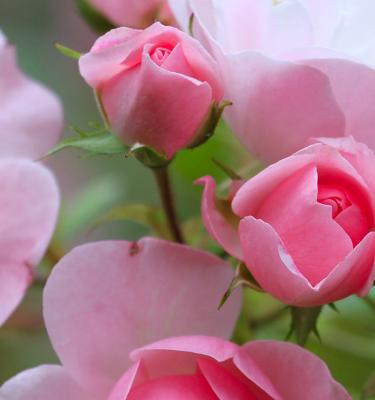

Growing Roses
Roses are among our favourite garden plants – and deservedly so. They are versatile, produce vibrant colour through spring and summer into autumn and many have delightful perfumes.
Different types of roses
There are literally thousands of different varieties and species of roses. First, you need to decide what type you want and the use it will be put to and then decide on colour and fragrance.
Miniature and patio roses
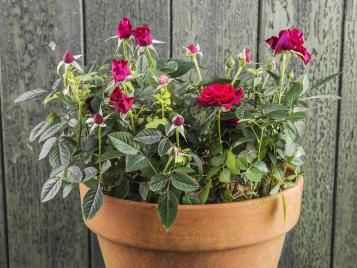
Dwarf roses range in height from 15-60cm high. They are perfect for the front of garden beds and small, deep containers.
Bush roses

This includes hybrid tea (large individual flowers), floribunda (dense clusters of blooms), heritage or heirloom roses and modern English roses (David Austin among others). They range in height from around 1m to 2m or more in height and are the main choice for garden beds and large containers.
Shrub roses
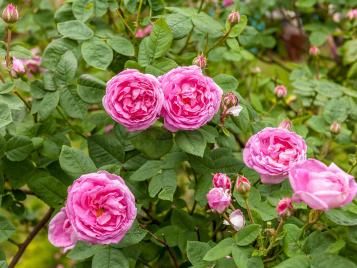
This is the term given to a broad group of roses that includes the old-fashioned varieties such as Bourbons, Centifolias and Albas, and species roses. Shrubs range from dwarf up to 2-3m high. Most are quite vigorous and only flower for a short period in summer.
Climbers and ramblers
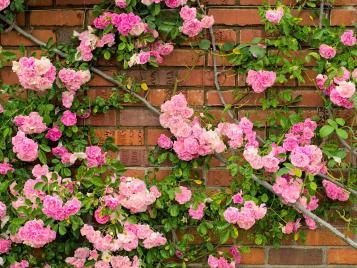
These are traditionally used to cover walls, fences, rose arches and pergolas. The main differences between the climbers and ramblers are that ramblers are more vigorous than climbers and only really suitable to cover large areas, they tend to only flower once in summer and usually produce clusters of smaller flowers. Climbers are less vigorous, more compact, product larger flowers and usually flower all summer long.
Ground cover or landscape roses
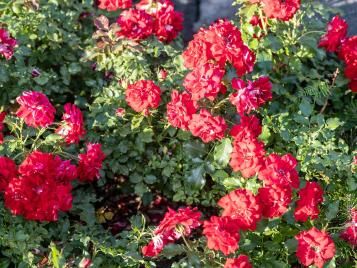
These low growing roses are useful for covering quite large areas of ground. Generally they don’t produce thick mats of foliage so don’t tend to be that useful for weed suppression, but are brilliant for producing a carpet of colour.
Standard roses
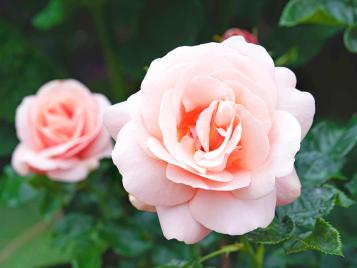
These have either a bus rose or a climbing or rambling rose (weeping standard) variety grafted on top of a single, upright stem. They come in a range of heights, including quarter, half and full standards.
Cultivating roses
When planting and growing roses, remember that most roses need good light, preferably full sun, and shelter from strong or cold winds. They benefit from good air circulation and plenty of space, so don’t plant them under trees or in dense shrub borders. Allow at least 1m between plants and 0.5m between plants and walls or fences. Roses develop quite deep roots and are hungry feeders so the soil needs to be thoroughly dug over and improved before planting. Dig in plenty of bulky organic material. Many rose growers prefer to use well-weathered manure but any organic matter will help ensure strong, healthy growth.
They prefer a well-prepared medium to heavy loam soil. Light, sandy soils tend to dry out quickly, nutrients leach away and they often fail to provide the physical support and anchorage needed to withstand strong winds. While roses will grow in lighter soils, the addition of abundant organic materials to improve soil texture and moisture retention will increase their chances of success.
Roses prefer soils that are mildly acidic (pH 5 – 6.5). If the soil is alkaline, treating it with sulfate of iron will help to make it more acidic.
Buying roses
You can buy roses in three different ways: bare-root, pre-packed and containerised, or container grown.
Bare-rooted roses and pre-packed roses
Pre-packed roses are basically the same as bare-rooted roses but have their roots encased in moss or a small amount of potting mix and wrapped in plastic. Bare-rooted and pre-packed roses are best planted in winter while the plants are dormant (without leaves and not actively growing). Soak the roots in a bucket of cool water for a couple of hours before planting, as the roots may be dry.
Potted and pot-grown roses
These can be planted from spring through to autumn but avoid planting in the peak of summer when hot soil temperatures may damage roots. Most roses in pots have been grown in the ground, then lifted and potted up – check plants they are growing strongly and have developed good root systems before planting out.
Always check the leaves, stems, and flowers, and only buy strong, healthy-looking plants. This will prevent many potential problems right from the start.
What you’ll need to grow roses
Having the right equipment will help you grow roses that are strong, healthy and beautiful. Here’s what you’ll need.
- Garden fork and spade
- Trowel
- Secateurs
- Scotts Osmocote® Rose, Gardenia, Azalea & Camellia Mix
- Scotts Osmocote® Controlled Release Fertiliser: Roses, Gardenias, Azaleas & Camellias
- Well-weathered animal or poultry manure
- Sulfate of iron (for very alkaline soils – pH more than 7)
- Premium quality garden soil, compost or soil improver
- Rose plants
For climbing roses:
- String or twine
- Support framework
How to plant and grow roses
For bare-root and pre-packed roses, dig out a hole large and deep enough to easily accommodate the spread-out roots, ensuring plants are at the same depth as they were in the field (check the soil mark on the main stem).
For potted roses, dig out a planting hole twice as wide and 5-7.5cm deeper than the pot.
Prepare a planting mixture of 50/50 garden soil mixed with Premium compost or soil improver and Scotts Osmocote® Controlled Release Fertiliser: Roses, Gardenias, Azaleas & Camellias at the recommended rate.
Line the base of the planting hole with a 5cm depth of the planting mixture, place the rose in the hole, checking that it is at the correct depth and fill the hole with the remainder of the planting mixture. Gently firm the planting mixture around the roots, then water in thoroughly.
Growing roses in pots and containers
Roses can be grown in large pots or planters with good drainage - choose a pot that’s at least 2 to 3 times bigger than the original nursery pot. You can always upgrade to bigger pots as your gardenia grows bigger.
Fill your pot or planter with Scotts Osmocote® Rose, Gardenia, Azalea & Camellia Mix. Gently remove the rose plant from the nursery pot and tease the roots lightly if they are compact. Plant the roses into the potting mix and back fill around the plant. Water in well and mulch over the surface of the potting mix to help retain moisture, but keep the mulch back from the plants main stems.
How to grow roses
As roses are deep-rooting plants, they are quite drought-tolerant and rarely need watering once they are established, particularly when growing in medium to heavy clay loams. In prolonged periods of hot, dry weather, however, they may need a deep watering once every 10-14 days.
Water onto the soil in the evening rather than in the heat of the day minimises water loss through evaporation, keeping the leaves dry to minimise the spread of diseases like black spots and mildews.
Roses are gross feeders. To maintain established roses, use a Scotts Osmocote® Controlled Release Fertiliser: Roses, Gardenias, Azaleas & Camellias in early spring and again in late summer.
Providing that the soil have been prepared well prior to planting and roses are fed correctly, nutrient deficiencies should not occur. If yellowing leaves do develop, the rose may be suffering from iron and/or manganese deficiencies. These can be fixed with trace elements treatments.
Likewise, pale patches towards the centres of leaves and areas of dead tissue near the main vein may indicate a lack of magnesium. Iron sulfate and/or Epsom salts will assist in balancing these deficiencies.
Organic mulches are extremely valuable in helping retain soil moisture as well as reducing the level of maintenance needed by suppressing weeds and keeping soils cool. Apply mulch as recommended on the bag.
Bush, ground cover, and standard roses are usually pruned in winter while dormant, to keep them looking tidy and within bounds. Regular deadheading to remove spent blooms over the growing seasons will encourage new growth and further flowering.
Common problems, pests and diseases in roses
| Rose black spot |
Black spot is one of the most common rose disease. This fungal disease causes spots on rose leaves, usually starting off as yellow areas which turn black. Affected leaves may drop early, reducing plant vigour.
|
|---|---|
| Rose rust |
Rose rust is a fungal disease. Yellow spots appear on the upper surfaces of leaves, with small orange pustules on the undersides that will turn black in summer. Large powdery orange deposits appear on stems. Affected leaves may drop early.
|
| Powdery mildew on roses |
Powdery mildew is another fungal diseases. It appears as white spots on leaves and can cause stunted growth and leaves to shrivel. Improve air circulation around plants, keep water off leaves and apply a fungicide to control it. |




